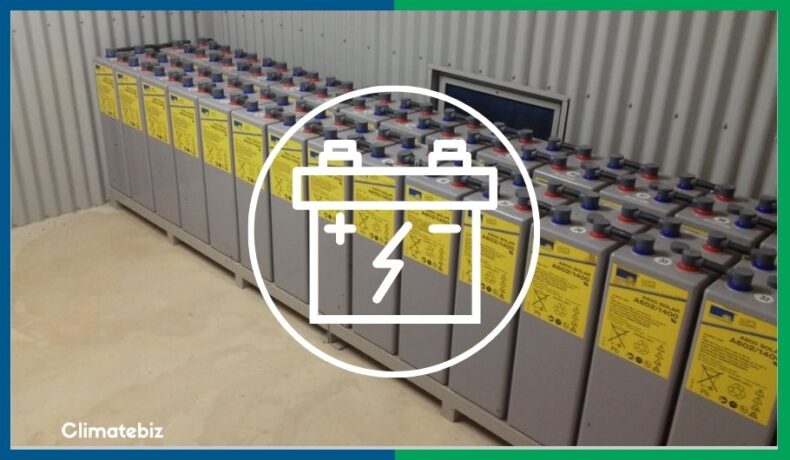LiFePO4 200Ah – What’s there to know?
The world of solar batteries can be pretty confusing.
There’s just so much (often misleading) information out there. Honestly, it makes figuring out where to start your off-grid journey rather tricky.
But worry not, we’re here to help!
If you’ve done just a little bit of research on how to store energy efficiently, you’ll know that the Lithium Iron Phosphate battery (LiFePO4) is the way to go.
But getting the question, “what’s the most efficient energy storage technology to date?”, out of the way has probably brought up several other questions, such as:
- How does a LiFePO4 battery work?
- How long do these batteries last?
- What do they cost?
To answer these and many other questions you may have, we’ve compiled an article with everything you need to know about 200Ah LiFePO4 batteries, in a simple yet informative way.
Let’s dive right in!
Table of Contents
What Is A 200Ah LiFePO4 Battery?
Let’s start with the basics:
A 200Ah LiFePO4 battery is a device used to store and provide electrical energy, consisting of one or more electrochemical cells where chemical reactions occur. These reactions convert chemical energy into electrical energy (and vice-versa).
They can be divided into two types: primary and secondary batteries.
In primary batteries, the chemical reactions are irreversible. In secondary batteries, the reactions can be reversed if external power is applied.
With that in mind, a LiFePO4 battery is a type of secondary lithium-ion battery due to its ability to store energy in the form of chemical energy and convert it into electrical energy upon demand.
Lithium Iron Phosphate is the material used as the cathode, hence the name of this battery.
Amp-Hours
“What about the 200 Ah? What does that mean?“
An ampere-hour (often referred to as “amp-hours” or simply Ah) is a measure of battery capacity. It expresses the amount of current you can draw from a battery during a certain amount of time.
Confused? Let’s explain:
“200 Ah” means you can draw 200 amperes for one hour of battery usage before it gets drained out.
It also means you can draw 1 ampere for 200 hours, or 2 amperes for 100 hours.
Do you see the logic here?
It holds true for other ampere values, as long as the multiplication ampere x hours results in 200 Ah.
Phew, that was a lot, right?
However, these are key pieces of information for you to understand what’s to come, so your effort will pay off.
How Does A 200Ah LiFePO4 Battery Work?
LiFePO4 batteries work in pretty much the same way as the other lithium-ion battery chemistries:
The exchange of lithium ions between electrodes (through the electrolyte) results in a flow of electrons through a load. This process is responsible for converting chemical energy into electrical energy (and vice-versa).
LiFePO4 cells are made of the following components:
- Cathode: LiFePO4
- Anode: Graphite
- Electrolyte: Lithium Salts in an organic solvent
- Separator: Polyethylene microporous membrane
- Current collectors: aluminum and copper foils
Below is an illustration that should help you understand how this battery works:
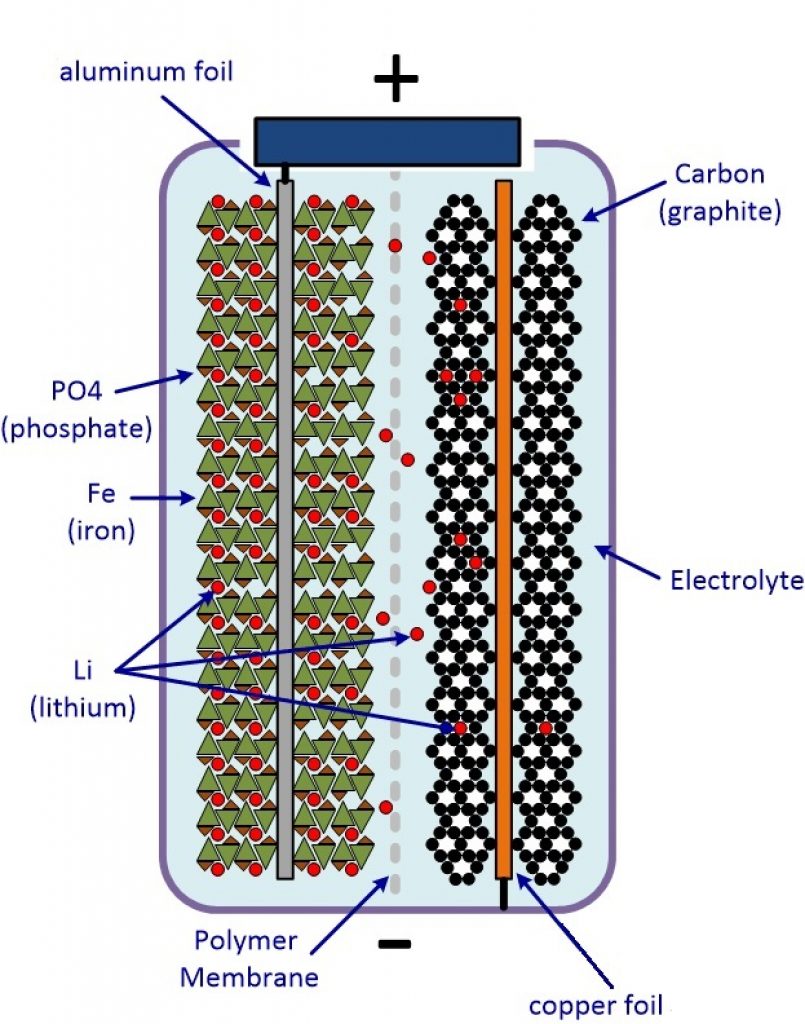
Adapted from solarcity.com
Process
During discharge, lithium ions move through the electrolyte to the positive electrode (LiFePO4). This process happens spontaneously, since the oxidation reaction of lithium (Li → Li+ + e–) is highly favorable.
Once the battery is discharged, the application of an external power forces the opposite (less favorable) reactions. So, when charging, the lithium ions are pulled from the cathode to the anode, through the electrolyte.
This way, the storage of electrical energy as chemical energy is possible.
How Many Life Cycles Does A 200Ah LiFePO4 Battery Have?
The term “life cycles” refers to the number of charge cycles a battery can perform before its capacity drops to 80% of its initial specified capacity. At this point, the battery’s performance reduces noticeably.
As previously mentioned, a “charge cycle” is the process of discharging and recharging a battery.
Each battery’s life cycle is affected differently, depending on how well they’re maintained. The level of production technology also plays a part in this.
In other words, your charging practices will determine how many cycles your 200Ah LiFePO4 battery will have.
Even though LiFePO4 batteries are more tolerant to full charge and abusive conditions (overcharge, low temperatures) than other lithium-ion chemistries, external factors and charging practices still affect their performance and overall lifespan.
With the above in mind, it’s easy to see how determining a 200Ah LiFePO4 battery’s number of life cycles is not so simple. This is because the number depends on how well you look after your battery.
Unlike the popular lead-acid batteries, LiFePO4 batteries are made of highly stable materials that don’t deteriorate easily with use. They are made to last a relatively long time.
On average, a 200Ah LiFePO4 Battery will perform up to 3000 cycles.
This is equivalent to 8 years, considering the battery performs one cycle (one discharge and recharge) a day.
A lot, right?
Compared to the 300 to 500 cycles a deep cycle lead-acid battery serves, yes, it’s a lot.
You’ll find different numbers for different manufacturers or battery models: some between 2000 to 4000 cycles and some between 4000 to 6000 cycles. But again, only time (and the way you treat your battery) will tell how many cycles it actually will perform.
How Much Does A 200Ah LiFePO4 Battery Cost?
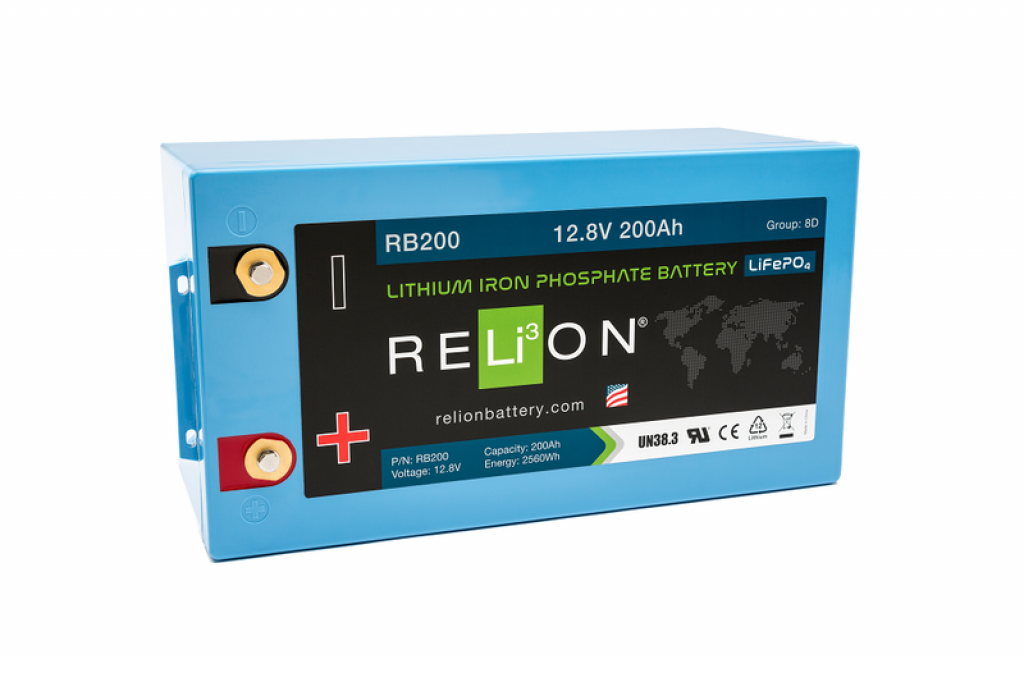
Source: relionbattery.com
200Ah LiFePO4 batteries are generally available in three voltages: 12V, 24V and 48V
Because there are so many brands that currently offer LiFePO4 batteries, it’s hard for us to provide you with accurate average prices, given that — surprisingly enough — concrete cost information on solar batteries isn’t easy to find online.
And when we do find them, they vary a lot from manufacturer to manufacturer.
For example, for a 12V 200Ah LiFePO4 battery, Ampere Time’s price is $699,99, while RELiON’s price is $1.996,95.
Of course, as quality varies, so do prices. But because very little data is available online, we don’t have a large enough data sample to provide you with a number that accurately reflects the average price of a 200Ah LiFePO4 battery.
In addition, the number of manufacturers that commercialize 24V or 48V 200Ah LiFePO4 batteries is very little, so these prices are even harder to find.
However, after spending a reasonable amount of time researching, we managed to gather some price information on 200Ah LiFePO4, which you can find in the table below:
| Manufacturer | Voltage | Price (in USD) |
|---|---|---|
| Ampere Time | 12V | $659.99 |
| Canbat | 12V | $1815.06 |
| Renogy | 12V | $1299.99 |
| AIMS Power | 12V | $1270 |
| Victron Energy | 12V | $2159 |
| Expert Power | 12V | $949.99 |
| RELiON | 12V | $1996.95 |
| Ampere Time | 24V | $1769.99 |
| RELiON | 24V | $4299.95 |
| RELiON | 48V | $7553 |
Using the above data, the average price of a 12V 200Ah LiFePO4 battery is roughly $1486.33.
Is A 200Ah LiFePO4 Battery Worth The Cost?
Finally, a question that’s easy to answer!
Yes, a 200Ah LiFePO4 battery is most definitely worth the cost.
It’s safe to say that one of the best energy storage solutions for large systems (house, vehicle, solar, etc.) nowadays are LiFePO4 batteries, and with good reason.
Advantages Of LiFePO4 Batteries
The advantages of LiFePO4 batteries over deep-cycle lead-acid batteries are shown below:
- Higher energy density
- Much longer lifespan
- Safer materials
- Little need for maintenance
- Much lighter (comparing same usable energy)
- Charge much faster
- More eco-friendly
- Low Self-discharge rates
- Made of stable compounds, which makes them non-combustible
- High tolerance to abusive conditions
- Superior thermal stability
- Overall greater efficiency
For these reasons, LiFePO4 batteries are starting to replace outdated lead-acid batteries.
To effectively compare these batteries in terms of cost-effectiveness, we need to compare how long they last (considering the same voltage and amp-hours specifications).
For comparison purposes, let’s consider these prices (which aren’t too different from reality):
| About the Battery | 12V 200Ah LiFePO4 battery | 12V 200Ah AGM deep cycle battery |
|---|---|---|
| Average upfront cost (in USD) | $1435 | $370 |
| Average number of cycles | 3000 | 300 |
| Total power stored/provided during battery life | 7200 kWh | 720 kWh |
This information indicates that you’d need 10 AGM deep cycle batteries to perform the same amount of cycles as only one LiFePO4 battery.
So, in the end, you would have spent 10 x $370 = $3700 on 12V 200Ah AGM deep cycle batteries to get the same amount of power as just one 12V 200Ah LiFePO4 battery.
Spending $1435 on a LiFePO4 battery doesn’t look so bad now, does it?
If these calculations weren’t clear to you, this is what’s important to know:
Even though LiFePO4 batteries have a higher initial cost when compared to lead-acid deep cycle batteries, they last much longer. So, in the end, during its lifespan, a LiFePO4 will cost less than a deep lead-acid cycle battery.
How Fast Can You Charge A 200Ah LiFePO4 Battery?
It depends on the charge current applied.
Usually, the recommended charging current for 12V 200Ah LiFePO4 falls between 10A to 50A.
Let’s consider that your LiFePO4 battery’s state of charge is at 20% and that the charger you’re using provides a charging current of 40A.
This means that you’d take 4 hours to charge your 200ah LiFePO4 battery up to a 100% state of charge.
That’s because you’d need to provide 80% of 200Ah, which is 160Ah. Since your charger provides a charging current of 40A, it would take 160Ah/40A = 4 hours to charge the battery.
This charging duration varies according to the charging current applied. Keep in mind that you should not exceed the recommended charging current for your battery.
What Can A 200Ah LiFePO4 Battery Power?
To understand what kind of load a 12V 200Ah LiFePO4 battery can power, let’s first calculate the amount of power this battery can provide:
Power = 12V x 200 Ah = 2400 Wh = 2,4 kWh (for a 100% Depth of Discharge)
For the recommended 80% DoD, this battery provides 1920Wh = 1,92 kWh
Knowing how many watt-hours you can get from a battery makes things easier because the rated load of appliances is usually expressed in terms of wattage.
So, let’s have a look at the average power ratings for common appliances (see table below):
| Appliance | Watts (Volts x Amps) | Hours per day | Wh per day |
|---|---|---|---|
| Inverter | 34 | 24 | 816 |
| 3 LED lights | 9 each | 5 | 135 |
| Laptop | 60 | 6 | 360 |
| Ceiling fan | 70 | 6 | 420 |
| Refrigerator | 170 | 11 | 1870 |
| Phone charger | 5 | 6 | 30 |
| Coffee maker | 1400 | 0,1 | 140 |
| Small LCD TV | 25 | 4 | 100 |
| Water filter and cooler | 80 | 10 | 800 |
| WiFi Router | 10 | 18 | 180 |
Now that you have the estimated power rating of appliances and the power provided by the battery expressed in the same unit (Wh), you can see what the battery is able to power.
Example
Taking into account the numbers shown in the previous table here’s what a 12V 200Ah LiFePO4 can power:
- Refrigerator for 11 hours
- Laptop for 5 days (6 hours/day)
- Ceiling fan for 4 days (6 hours/day)
- Phone charger, Laptop, 3 LED lights, WiFi Router, Small LCD TV and a Coffee maker for 2 days (according to the hours/day described)
This logic can be extended to other cases, you just have to:
- Calculate your battery’s power capacity
- Check the power rating of your appliances
- See what can be powered according to these numbers
In conclusion, such a battery will run a variety of home appliances with different power ratings but the run time will decrease as the demand for wattage increases.
What Voltage Is A 200Ah LiFePO4 Battery?
Batteries are an assembly of several cells. The number of cells in a battery will determine its nominal voltage.
LiFePO4 cells have a nominal voltage of 3.2V. Therefore, to achieve a 12V battery, four cells are connected in series. This would result in a nominal voltage of 12.8V.
Similarly, connecting eight cells in a series provides a 24V LiFePO4 battery, with a nominal voltage of 25.6V.
Lastly, connecting sixteen cells in a series provides a 48V LiFePO4 with a nominal charge of 51.2V.
To summarize, 12V, 24V, and 48V are the standard voltages of a 200Ah LiFePO4 battery and work well with your typical 12V, 24V, and 48V inverters.
However, the use of 12V batteries is more widespread, while 24V and 48V LiFePO4 batteries are difficult to come across (although 24V LiFePO4 are more easily found in larger storage systems).
Can a 200Ah LiFePO4 Battery Start A Car?
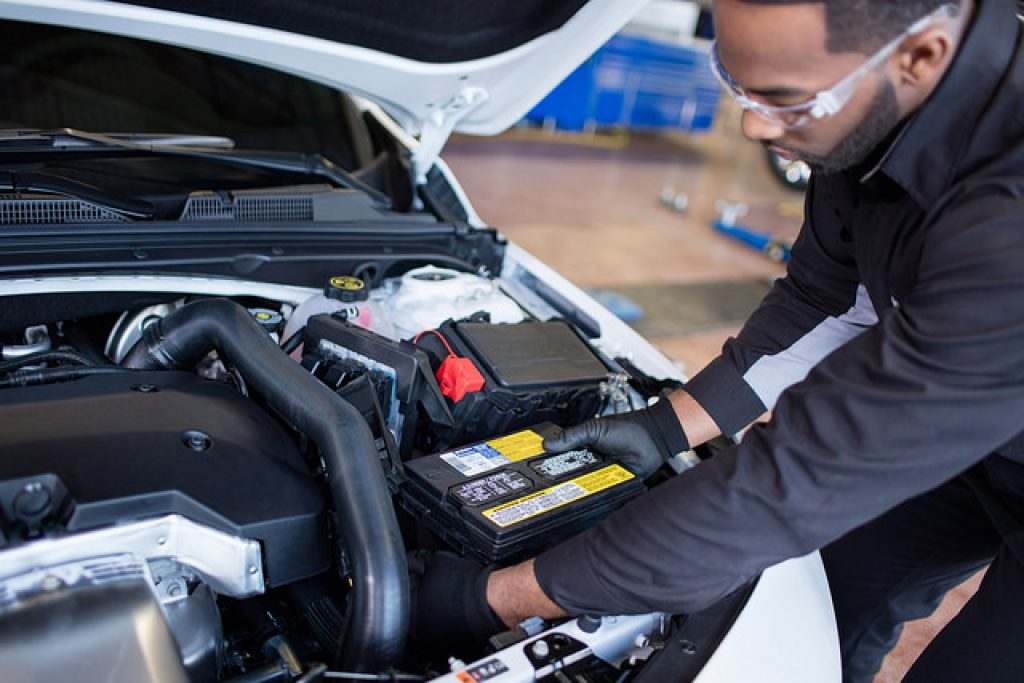
Source: lancastertoyota.com
Theoretically speaking, yes. Although LiFePO4 batteries are designed for long, relatively slow power outputs, they could also act as a starter battery, providing a large surge of power for a short period.
Typically, the starting current of a compact popular car is in the 150-200A range, depending on the battery voltage. For a 12V battery, the engine will require approximately 200 amps to start.
If you look at a 12V 200Ah LiFePO4 battery’s discharge specifications, you’ll find its “peak discharge current” (see image below).
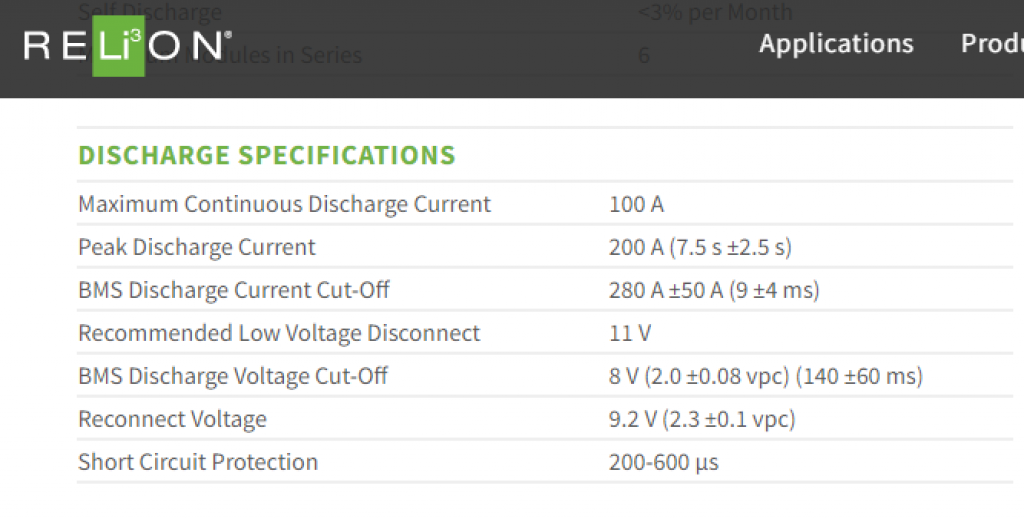
Source: relionbattery.com
As you can see, this 200Ah LiFePO4 battery can provide a Peak Discharge Current of 200A (for 7.5 seconds), which is enough to start a regular car.
However, that doesn’t mean you should use them for this purpose since they aren’t designed for this. In this case, lead-acid batteries are a better choice.
LiFePO4 batteries have much higher capabilities than the standard starter batteries (lead-acid), which aren’t needed for starting engines.
Firstly, the surge current required to start a car could kill your battery’s BMS, rendering the battery useless.
Secondly, using a LiFePO4 battery as a starter battery could damage your alternator.
Once the battery starts the engine, the alternator takes over and charges the car’s battery. Because a LiFePO4 battery has a low internal resistance, it draws as much current as the alternator can provide.
So, although you could — in theory — start a car with a LiFePO4 battery, it doesn’t mean this practice is recommended.
Final Thoughts
For those of you who were unsure about becoming a proud owner of a brand new LiFePO4 200Ah battery — we hope this article convinced you to go ahead and invest in one!
When it comes to storing energy efficiently, LiFePO4 batteries are one of the safest and most reliable options on the market. Despite their high initial cost, they make up for it with their long lifespan.

